


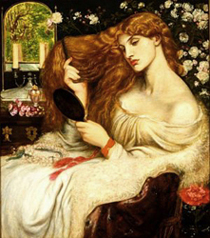

Art in Willa Cather's Fiction
The Professor's House (1925)

The extent to which Willa Cather was interested in and influenced by art has been carefully documented by Polly P. Duryea in her 1993 dissertation Paintings and Drawings in Willa Cather's Prose: A Catalogue Raisonne. To facilitate appreciation of Cather's art allusions, I have gathered together here images of the art identified by Duryea and selected quotations and commentary from her dissertation.
Cather's The Professor's House (1925) is a novel about Professor St. Peter's midlife crisis as he moves reluctantly into the modern era that contrasts with the earlier world of his former student, Tom Outland, whose story-within-a-story is set in the Southwest.

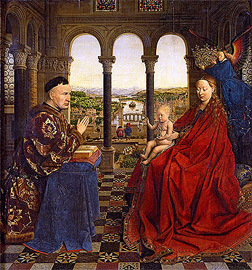

(Left) Jan Van Eyck, The Virgin of Chancellor Rolin, 15th Century
(Right) Pieter de Hooch, Woman Reading a Letter, 17th Century.
- Most readers assume that Cather's window analogy refers to Vermeer's painting, but a search of the internet does not reveal many significant open windows, much less distant vistas of ships or the sea, in Vermeer or in any other Dutch paintings. Since no one seems to know for sure which paintings Cather saw in Paris, I have included one earlier Flemish painting which does show a distant ship.
- Cather's statement about her "window" experiment with form in The Professor's House:
- ". . . Just before I began the book I had seen, in Paris, an exhibition of old and modern Dutch paintings. In many of them the scene presented was a living-room warmly furnished, or a kitchen full of food and coppers. But in most of the interiors, whether drawing-room or kitchen, there was a square window, open, through which one saw the masts of ships, or a stretch of grey sea. The feeling of the sea that one got through those square windows was remarkable, and gave me a sense of the fleets of Dutch ships that ply quietly on all the waters of the globe--to Java, etc.
- Cather:
- "In my book I tried to make Professor St. Peter's house rather over-crowded and stuffy with new things; American proprieties, clothes, furs, petty ambitions, quivering jealousies--until one got rather stifled. Then I wanted to open the square window and let in the fresh air that blew off the Blue Mesa, and the fine disregard of trivialities which was in Tom Outland's face and in his behaviour." (News Letter, Dec. 12, 1938, in Stephen Tennant, ed., Willa Cather on Writing, New York: Knopf, 1949, pp. 30-32.)

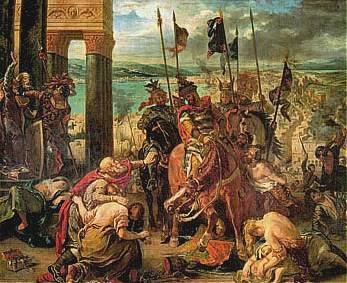
Eugène Delacroix, Entry of the Crusaders into Constantinople 12 April 1204
- Duryea notes that "Jean Schwind associates this painting with Professor St. Peter's tableaux vivant in The Professor's House (Schwind Diss. 73-74). For Delacroix's influence on Cather's Professor Godfrey St. Peter, see Bohlke, L. Brent. "Godfrey St. Peter and Eugène Delacroix: A Portrait of the Artist in The Professor's House?" Western American Literature 17 (May): 21-38."


Anthony Van Dyck, Portrait of Frans Snyders
- Duryea notes that "Van Dyck's portrait of Frans Snyders, now at the British Museum, resembles Cather's described features for Professor Godfrey St. Peter in The Professor's House (12-13)."
- Cather:
- "He had a long brown face, with an oval chin over which he wore a close-trimmed Van Dyke, like a tuft of shiny black fur. With this silky, very black hair, he had a tawny skin with gold lights in it, a hawk nose, and hawk-like eyes--brown and gold and green. They were set in ample cavities, with plenty of room to move about, under thick, curly, black eyebrows that turned up sharply at the outer ends, like military moustaches. His wicked-looking eyebrows made his students call him Mephistopheles--and there was no evading the searching eyes underneath them; eyes that in a flash could pick out a friend or an unusual stranger from a throng (PH 12-13)."

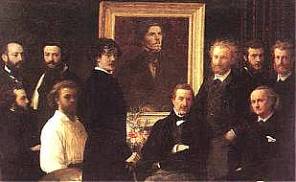
Ignace-Henri-Jean-Théodore Fantin-Latour, Homage to Delacroix (1864)
- According to Duryea, "In an earlier tableau, Homage to Delacroix (1864), Fantin-Latour painted 'himself, Baudelaire, Manet, Whistler [a close friend] and others grouped around a portrait of Delacroix' (quote from Random 181). Fantin-Latour's Delacroix painting is echoed by Godfrey St. Peter's nostalgic wish for an 'homage to Delacroix' found in The Professor's House."

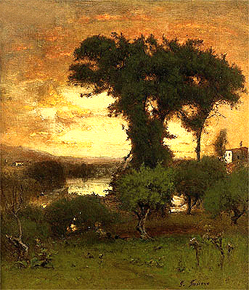
George Inness, The Afterglow
- Duryea claims, "After a search of the records at the Art Institute, I am convinced that The Afterglow is the Inness painting that Cather's called "Prairie Fire." Like Inness, Cather often uses luminous raking light--especially when the sun sees the moon--that accompanies the epiphanic moments when the course of the character's life is changed."
- Cather:
- "When I [Tom Outland] pulled out on top of the mesa [blue], the rays of sunlight [yellow] fell slantingly through the little twisted piñons [green],--the light was all in between them, as red as a daylight fire [red], they fairly swam in it. Once again I had that glorious feeling that I've never had anywhere else, the feeling of being on the mesa [blue], in a world above the world. And the air, my God, what air!--Soft, tingling, gold, hot with an edge of chill on it, full of the smell of piñons [green]--it was like breathing the sun [yellow-gold], breathing the colour of the sky [blue, gold, red]. Down there behind me was the plain [varied], already streaked with shadow [black], violet and purple and burnt orange until it met the horizon [blue/black plus sky]. Before me was the flat mesa top [blue], thickly sprinkled with old cedars [dark green] that were not much taller than I, though their twisted trunks [brown] were almost as thick as my body. I struck off across it, my long black shadow going ahead" (PH 240).


Photo of Mesa Verde, Colorado.
Go to Mesa Verde National Park: The Anasazi--good history of the "ancient cliff dwellers."
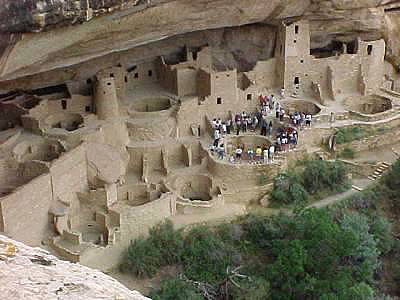
Photo of contemporary tourist group at Mesa Verde
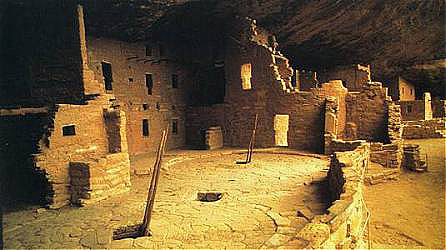
Close-up photo of Mesa Verde dwelling
- Tom Outland's description of Blue Mesa [Mesa Verde, Colorado]:
- "Far up above me, a thousand feet or so, set in a great cavern in the face of the cliff, I saw a little city of stone, asleep. It was as still as sculpture--and something like that. It all hung together, seemed to have a kind of composition: pale little houses of stone nestling close to one another, perched on top of each other, with flat roofs, narrow windows, straight walls, and in the middle of the group, a round tower . . . . A fringe of cedars grew along the edge of the cavern, like a garden. . . . That village sat looking down into the canyon with the calmness of eternity. . . . It was more like sculpture than anything else. I knew at once that I had come upon the city of some extinct civilization, hidden away in this inaccessible mesa for centuries, preserved in the dry air and almost perpetual sunlight like a fly in amber, guarded by the cliffs and the river and the desert." (Professor's House, pp. 199, 201-2).

Related Resources:
Death Comes for the Archbishop
Comments/Suggestions: knichols11@cox.net
Updated: 12-14-12


